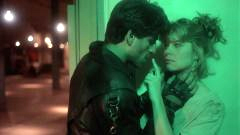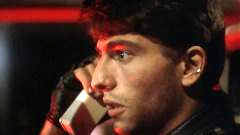 ALPHABET
CITY (1984) Blu-ray
ALPHABET
CITY (1984) Blu-rayDirector: Amos Poe
Fun City Editions/Vinegar Syndrome
 ALPHABET
CITY (1984) Blu-ray
ALPHABET
CITY (1984) Blu-ray"At 19, they gave him the streets. Tonight, they're going to take them back," in Fun City Editions' Blu-ray of the stylish and gritty ALPHABET CITY.

Johnny (Vincent Spano, OSCAR) aka "Chunga" is the king of Alphabet City, collecting protection fees from local establishments and drug money from his dealers – among them Lippy (POLICE ACADEMY's Michael Winslow) – on behalf of Don Corleone-complex mobster Gino (Ray Serra, SPLITZ). Tonight, however, Gino has commanded that Johnny burn down a building for the insurance; the problem is that it's the apartment building where his mother (Zohra Lampert, LET'S SCARE JESSICA TO DEATH) and sister Sophia (Jami Gertz, THE LOST BOYS) are currently living. His proud mother refuses to be intimidated, and his hooker sister ridicules his tough guy image when he begs her to take their mother and run (that is until he gives her a stack of cash). His artist girlfriend Angela (Kate Vernon, PRETTY IN PINK) is tired of his promises to change for the sake of their infant daughter and is not willing to uproot her life even in the face of danger. Johnny stalls on torching the building under the guise of doing regular business, but Gino has eyes everywhere and tells him that there is only one way out of the family and "no one is indespersible (sic)!"
 Shot
through with rain-slick streets, smoke, color gel lighting, and New Wave music
that projects an air of MTV cool, ALPHABET CITY with its macho hero on an episodic
journey is like a non-sexual version of Paul Schrader's AMERICAN GIGOLO. The
storytelling is elliptical and drags a little in the middle, but that is entirely
suited to the thematic question of "When are you finally going to change,
Johnny?" We get a look at his life as he stalls trying to decide between
"it's going to get burned down anyway" and getting out not because
he can no longer hack it but because he no longer wants to do it. ALPHABET CITY
is not really an action film and it is in some ways barely a character drama;
that is, pretty much all of the film's dramatic exchanges could have been a
trite backdrop to Poe's visual style if not for Spano's anchoring performance
in the face of various acting and delivery styles ranging from over-the-top
to "character actor" takes. While one wonders if Johnny has really
impressed upon his family and girlfriend the danger of working for the mob with
their dramatic "I won't be pushed around" responses, most moving is
his scene with stoned drug dealer Lippy which at first seems like a dressing
down but gradually conveys a real concern for the path the latter is going down
in light of Johnny's own personal realizations. The last fifteen minutes almost
feels like a concession to genre conventions but one cannot help but root for
Johnny even if he remains only slightly more sketched out a character than the
rest. Director Amos Poe had previously helmed the punk documentary THE BLANK
GENERATION and was influenced by the "other New Wave" with his subsequent
features UNMADE BEDS, THE FOREIGNER, and SUBWAY RIDERS. He followed up ALPHABET
CITY with a series of music videos including Animotion's "Obsession".
Presumably Poe met the film's co-writer Gregory Heller while he was living in
Paris since Heller's only other credit is scripting the English dialogue of
the American characters for Jean Rollin's THE LIVING DEAD GIRL.
Shot
through with rain-slick streets, smoke, color gel lighting, and New Wave music
that projects an air of MTV cool, ALPHABET CITY with its macho hero on an episodic
journey is like a non-sexual version of Paul Schrader's AMERICAN GIGOLO. The
storytelling is elliptical and drags a little in the middle, but that is entirely
suited to the thematic question of "When are you finally going to change,
Johnny?" We get a look at his life as he stalls trying to decide between
"it's going to get burned down anyway" and getting out not because
he can no longer hack it but because he no longer wants to do it. ALPHABET CITY
is not really an action film and it is in some ways barely a character drama;
that is, pretty much all of the film's dramatic exchanges could have been a
trite backdrop to Poe's visual style if not for Spano's anchoring performance
in the face of various acting and delivery styles ranging from over-the-top
to "character actor" takes. While one wonders if Johnny has really
impressed upon his family and girlfriend the danger of working for the mob with
their dramatic "I won't be pushed around" responses, most moving is
his scene with stoned drug dealer Lippy which at first seems like a dressing
down but gradually conveys a real concern for the path the latter is going down
in light of Johnny's own personal realizations. The last fifteen minutes almost
feels like a concession to genre conventions but one cannot help but root for
Johnny even if he remains only slightly more sketched out a character than the
rest. Director Amos Poe had previously helmed the punk documentary THE BLANK
GENERATION and was influenced by the "other New Wave" with his subsequent
features UNMADE BEDS, THE FOREIGNER, and SUBWAY RIDERS. He followed up ALPHABET
CITY with a series of music videos including Animotion's "Obsession".
Presumably Poe met the film's co-writer Gregory Heller while he was living in
Paris since Heller's only other credit is scripting the English dialogue of
the American characters for Jean Rollin's THE LIVING DEAD GIRL.

Released theatrically by Atlantic Releasing (NOMADS, STORMY MONDAY), ALPHABET CITY was released on videotape by CBS/Fox and on anamorphic widescreen DVD by MGM. Fun City Editions' inaugural Blu-ray is derived from a new 2K scan of the original 35mm interpositive and it is a stunner if one takes into account the visual style and the limitations of the production. In addition to the night location shooting, saturated color gels, and backlighting, it appears as if the flare of the light sources was not through the use of star filters but shooting with the lens aperture wide open leading to some extremely shallow depth-of-field and some lagging focus in scenes with movement. Close-ups reveal strong detail in facial features, eighties hair, costumes, and the grit of the streets and abandoned buildings while saturated color really pop throughout. There are plenty of other shots that are soft due to the aforementioned depth-of-field in low light and the heavy use of diffusing smoke. The DTS-HD Master Audio 2.0 mono track conveys dialogue clearly along with effects and the great soundtrack, and optional English SDH subtitles are included.
 The
film is accompanied by an optional introduction by actor Spano (0:33) as well
as an audio commentary by director Poe and writer friend Luc Sante in which
the director recalls that he and producer Andrew Braunsberg (MACBETH) had been
trying for a few years to find a project together, vetoing each other's ideas
until associate producer Roberta Friedman showed them an outline for a film
titled ALPHABET CITY (a term only recently coined at the time). Of the film's
visual style, he reveals that he did not want rain-slicked streets because that
meant every location would have to be watered down since it was set on one night,
but it happened to be raining when they filmed the opening credits sequence.
He also notes that a number of scenes were lost due to the budget being cut
and had to be worked around in the editing (one early scene he notes missing
actually leads to more effective storytelling), and he also reveals that the
shooting was done only a few months ahead of the large scale gentrification
of the area when buildings were being bought up and flipped and East Village
galleries were pretty much Ponzi schemes in the making. He also notes that music
producer/composer Nile Rogers ("Le Freak") had been hired before himself,
and that cinematographer Oliver Wood had not shot a film since THE HONEYMOON
KILLERS but would get hired for the TV show MIAMI VICE based on his work here.
The
film is accompanied by an optional introduction by actor Spano (0:33) as well
as an audio commentary by director Poe and writer friend Luc Sante in which
the director recalls that he and producer Andrew Braunsberg (MACBETH) had been
trying for a few years to find a project together, vetoing each other's ideas
until associate producer Roberta Friedman showed them an outline for a film
titled ALPHABET CITY (a term only recently coined at the time). Of the film's
visual style, he reveals that he did not want rain-slicked streets because that
meant every location would have to be watered down since it was set on one night,
but it happened to be raining when they filmed the opening credits sequence.
He also notes that a number of scenes were lost due to the budget being cut
and had to be worked around in the editing (one early scene he notes missing
actually leads to more effective storytelling), and he also reveals that the
shooting was done only a few months ahead of the large scale gentrification
of the area when buildings were being bought up and flipped and East Village
galleries were pretty much Ponzi schemes in the making. He also notes that music
producer/composer Nile Rogers ("Le Freak") had been hired before himself,
and that cinematographer Oliver Wood had not shot a film since THE HONEYMOON
KILLERS but would get hired for the TV show MIAMI VICE based on his work here.
 The
disc also features "Prince of Alphabet City" (21:59), an interview
with Spano who recalls his beginnings as a child actor, missing school to go
on Broadway and tour with "The Shadow Box" before landing a quick
succession of roles including THE DOUBLE McGUFFIN and OVER THE EDGE as well
as the Coppola pair THE BLACK STALLION RETURNS and RUMBLE FISH just before ALPAHBET
CITY. He recalls growing up knowing that you did not go to the area of the film's
setting but did not actually experience any trouble during the film's production.
He notes that actor Daniel Jordano (DEATH WISH 3) was a childhood friend of
his and he helped him prepare an audition for the film, and that they choreographed
their fight scene late in the film after the stunt doubles Braunsberg insisted
on using were less than impressive. He also humorously recalls his poor decision
in taking the film's Trans-Am for a joyride during a break in the shooting.
"East Side Stories" (4:48) is a video essay by filmmaker Chris O’Neill
– narrated by another voice artist – in which he explores the influences
of German Expressionism and film noir on the film's visual style (Poe mentioned
on the commentary that he wanted to shoot the film in black and white and that
the executive producers did not realize the budget did not originally take the
cost of color stock into account – as well as the importance of Spano's
consistent performance in mediating the variety of acting styles of the supporting
players. The disc also features a theatrical trailer (2:27) and image gallery.
The cover is reversible while a special limited edition embossed slipcover limited
to 2,000 units is only available directly from Vinegar
Syndrome. (Eric
Cotenas)
The
disc also features "Prince of Alphabet City" (21:59), an interview
with Spano who recalls his beginnings as a child actor, missing school to go
on Broadway and tour with "The Shadow Box" before landing a quick
succession of roles including THE DOUBLE McGUFFIN and OVER THE EDGE as well
as the Coppola pair THE BLACK STALLION RETURNS and RUMBLE FISH just before ALPAHBET
CITY. He recalls growing up knowing that you did not go to the area of the film's
setting but did not actually experience any trouble during the film's production.
He notes that actor Daniel Jordano (DEATH WISH 3) was a childhood friend of
his and he helped him prepare an audition for the film, and that they choreographed
their fight scene late in the film after the stunt doubles Braunsberg insisted
on using were less than impressive. He also humorously recalls his poor decision
in taking the film's Trans-Am for a joyride during a break in the shooting.
"East Side Stories" (4:48) is a video essay by filmmaker Chris O’Neill
– narrated by another voice artist – in which he explores the influences
of German Expressionism and film noir on the film's visual style (Poe mentioned
on the commentary that he wanted to shoot the film in black and white and that
the executive producers did not realize the budget did not originally take the
cost of color stock into account – as well as the importance of Spano's
consistent performance in mediating the variety of acting styles of the supporting
players. The disc also features a theatrical trailer (2:27) and image gallery.
The cover is reversible while a special limited edition embossed slipcover limited
to 2,000 units is only available directly from Vinegar
Syndrome. (Eric
Cotenas)